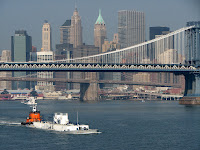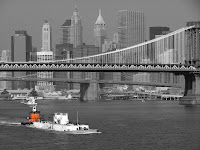test
--
...
Tuesday, October 11, 2016
Tuesday, November 11, 2008
Example of "Focus B&W" function in Picasa
This is Manhattan in NYC with Manhattan Bridge in the foreground.


I was able to leave out fairly well defined orange structure of the tug boat and convert the rest of the image to B&W. The key to having this feature look natural (and in many cases, like there was a lot of touch up work involved) is the image selection. The area intended to remain in color, must be well defined and not have "busy" surroundings, so as to avoid the "spill over" effect. Keep in mind, that in order to have such a feature applied in auto, programmer's used a circle as a basic shape. While the blending sharpness (or feathering effect of the transition) can be adjusted, it's still far from flexible enough for many cases. So be judicious in choosing the image and you will like the outcome. Bottom line: there is a lot to appreciate about Picasa. In the very least, it will show you the potential of digital manipulation. Sophisticated programs (like Photoshop, Paint Shop Pro, and perhaps most importantly the free GIMP) give an actual total control of what can be done, with an appropriate learning curve to go along of course.
If you would like to see some of other Picasa features applied, check out this short piece with examples of focus and tonal changes.
...
Posted by
editor in chief
at
07:57
0
comments
![]()
![]()
Labels: Photographs, Picasa, Places, Technique
Monday, November 10, 2008
Adding a new feature
Oh, don't be scared, that's just me looking after you.
...
One: to prevent unnecessary manipulation of my images by unrelated parties, or
Two: to minimize unnecessary manipulation of my images by unrelated parties, or
Three: to discourage unnecessary manipulation of my images by unrelated parties, and
Four: to entice the interested to my images, which have NOT been manipulated by unrelated parties
How is this going to work? I won't go too fancy, but if any of my posts contains a photograph that I deem worth wider exposure, I will post links to proper resolutions. I will also tag such posts as "wallpaper", so one can quickly find all of them in the future. You can email me of course with a specific image request and I shall oblige at my earliest convenience.
The Brooklyn Bridge in the post prior has been chosen to initiate this deal (just wait for it a few please). A free deal by the way, but give credit where credit is due. I always do. Thank you.
...
Posted by
editor in chief
at
16:44
0
comments
![]()
![]()
Labels: Announcements, Photographs, Wallpaper
I've been away, I've been busy, I've been ... well, still shootn'
The engineering marvel of its time, the Brooklyn Bridge.

and the monument of the free World, Statue of Liberty

...
Posted by
editor in chief
at
16:24
0
comments
![]()
![]()
Labels: Photographs, Places
Monday, March 10, 2008
Tuesday, February 26, 2008
Choosing your web site host
I have a couple of hosts that I highly recommend. Each is somewhat different. First is great for a single site, second for multiple sites.
First is: Webstrike Solutions. This is a high quality host for not much money, although the cost is somewhat higher than you may be used to seeing. I used to host with them and was nothing but extremely happy with overall service, support, server up-time and site accessibility. They have recently updated their site and packages, but did leave ONE major advantage intact: you pay $30 set up fee and you have your site hosted for 12 months with no other charges. This is especially great for the uncertain ones, who are contemplating their own site, but cannot decide. If you cancel by the end of the 12-month period, you pay nothing more. Check their packages, it's worth a few minutes of your time.
I left Webstrike for unrelated reasons and am currently hosting with Host Gator. I simply needed a reseller package and the flexibility of setting up unlimited domains, something Webstrike did not have (and still doesn't I believe). Host Gator has been very good and I have no plans looking for a change at this time.
This is, of course, only a couple of good hosts. There is more, but there is far more bad ones.
So the word of caution for those who fall for the cheap $5 per month / 50gB storage packages. It never works that way. It sounds too good and IT IS. If you're not sure what to choose, log on to Web Hosting Talk. There is enough to keep you busy for days. In fact, it might get a bit overwhelming at first, but read on and you'll finally see through all the scams. Remember also, that many will "supply" good care in the early stages of your agreement. That's especially true, if you signed up long term and have a 30-day "leave-for-no-reason" guarantee.
...
Posted by
editor in chief
at
14:38
0
comments
![]()
![]()
Labels: Articles, Web Publishing
Friday, February 22, 2008
The "American Queen"
...
Posted by
editor in chief
at
12:41
0
comments
![]()
![]()
Labels: Photographs, Places
Thursday, February 21, 2008
Foggy riverside
...
Posted by
editor in chief
at
10:27
0
comments
![]()
![]()
Labels: Photographs, Places, Technique
Wednesday, February 20, 2008
Small web site about skansens in Poland
...
Posted by
editor in chief
at
20:09
0
comments
![]()
![]()
Labels: Photographs, Places
Wednesday, February 13, 2008
Tank farm
...
Posted by
editor in chief
at
13:16
0
comments
![]()
![]()
Labels: Photographs, Technique
Tuesday, February 05, 2008
Exposing for RAW?
Assuming the author is correct (as I have no way of checking that out, but have no reason to believe otherwise), the histogram and LCD preview on ALL digital cameras are based on processed JPEG file, EVEN if you only shoot RAW. This means that one is looking at a (vastly) different data that RAW records. In extreme cases, your RAW will horribly disappoint later on. You may get to thinking: what did I do wrong? everything looked great on the histogram?
One: keep above in mind in such situations
Two: try to adjust your camera JPEG settings to see if you can get preview match RAW more closely (useless if you shoot JPEG also and unlikely to give you exact match)
Three: learn correct exposure techniques so you rely on the technique rather than the preview/histogram
The mentioned article (titled: Exposing for RAW by Andrew Rodney) is about a so called ETTR technique, that's Expose To The Right, or expose for highlights and develop for such. Film shooters may remember the EFSDFH (expose for shadows develop for highlights), which in most cases gave us the most printable negative. However, the bottom line is only one:
expose to ensure detail where it counts most, yet don't lose the highlights (unless this is your wish, of course)
I can't copy the whole article here (obviously), but I do recommend reading it. It might just fix some of your shooting techniques. The whole article is available HERE. You can even print it.
Digital Photo Pro is a bimonthly magazine targeting the digital photographer. It is (in my opinion) a high quality publication, although somewhat uneven issue to issue. It goes at newsstand for $5.99 and can be subscribed to for much less.
Posted by
editor in chief
at
09:21
0
comments
![]()
![]()










